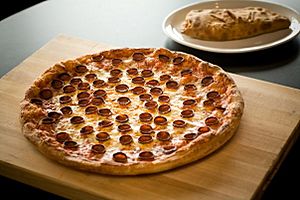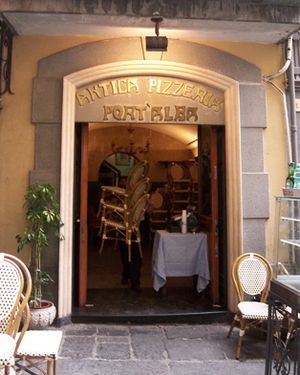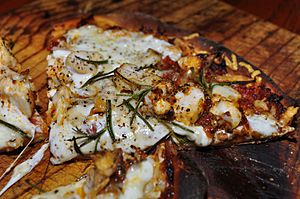History of pizza facts for kids
The history of pizza starts a long, long time ago, in ancient times. Back then, people made simple flatbreads and added different toppings to them.
A very early version of pizza was probably focaccia. This was a flat bread that the Romans called panis focacius. People would then add toppings to it. The modern pizza we know today grew from similar flatbreads in Naples, Italy. This happened in the 1700s or early 1800s.
The word pizza was first written down in the year 997 AD in a town called Gaeta. After that, it appeared in different parts of Central and Southern Italy. For a long time, pizza was mostly eaten in Italy. Only people who moved away from Italy ate it too. This changed after World War II. Soldiers from other countries were stationed in Italy. They tried pizza and other Italian foods and loved them!
Contents
Where Did Pizza Come From?
In Sardinia, archaeologists from France and Italy found bread baked over 7,000 years ago. Experts believe the people on the island made this bread rise. Foods like pizza have been made since ancient times. There are old records of people adding ingredients to bread to make it taste better.
- In the 500s BC, Persian soldiers serving under Darius the Great baked flatbreads. They put cheese and dates on top. They even baked them on their battle shields!
- In Ancient Greece, people made a flat bread called plakous. They added toppings like herbs, onion, cheese, and garlic to it.
- An early mention of a pizza-like food is in a very old poem called the Aeneid (around 19 BC). In this story, Aeneas and his men eat round cakes, like pita bread, topped with cooked vegetables. When they eat the bread, they realize it's part of a prophecy!
Some people think modern pizza came from pizzarelle. These were kosher cookies eaten by Roman Jews after going to the synagogue on Passover. Others think it came from different Italian breads eaten during that holiday. Some scholars even believe pizza was first made over 2,000 years ago. They say Roman soldiers added cheese and olive oil to matzah.
Other flatbreads from the ancient Mediterranean world still exist today. These include focaccia, which might be as old as the Etruscans. There's also Manakish from the Middle East, and coca from Spain. The Greek Pita and Piadina from Italy are also similar.
Other flatbreads around the world are like pizza too. Chinese bing is a flat, round bread. Indian paratha and naan are also flatbreads. There are also many pies in Europe that are like pizza. They have cheese, meat, vegetables, and seasonings on a flat pastry. Examples are German flammkuchen and French quiche.
In the 1500s, in Naples, a flatbread was called a pizza. It was known as a poor person's food. It was sold in the street and not seen as a fancy dish. Later, people started adding oil, tomatoes, or fish to it. Tomatoes came to Europe from the Americas. In 1843, a writer named Alexandre Dumas wrote about all the different pizza toppings.
A famous story says that on June 11, 1889, a pizzamaker named Raffaele Esposito made a special pizza. He made it for the Queen of Italy, Margherita of Savoy. This pizza was called "Pizza Margherita". It had tomatoes, mozzarella, and basil. These colors matched the Italian flag.
Pizza became a dish with bread and tomato, often with cheese. But until the late 1800s, pizza was often sweet, not savory. Earlier savory versions were more like flatbreads called schiacciata. A famous cookbook from the early 1900s, La Scienza in cucina e l'Arte di mangiar bene, had three pizza recipes, and all were sweet! Later, the author added a savory recipe for "pizza alla napoletana" with mozzarella, tomatoes, anchovies, and mushrooms.
By 1927, another well-known Italian cookbook, il talismano della felicità, included a recipe using tomatoes and mozzarella.
How Pizza Changed and Grew
A big change that led to modern pizza was using tomato as a topping. When tomatoes were first brought to Europe from the Americas in the 1500s, many people thought they were poisonous. This was because they are related to some poisonous plants.
However, by the late 1700s, poor people around Naples often added tomatoes to their flatbreads. This is how pizza really began! The dish became very popular. Soon, visitors to Naples would go to the poorer parts of the city just to try this local food.
Records show that in 1807, there were already 54 pizzerias in Naples. By the late 1800s, this number grew to 120.
In Naples, there were also pizza sellers who didn't make the pizza themselves. There were also sellers who made pizzas but let people pay for them seven days later.
The pizza marinara has toppings of tomato, oregano, garlic, and olive oil. It's called "marinara" because sailors' wives traditionally made it. They made it for their husbands when they came home from fishing in the Bay of Naples.
The margherita pizza has tomato sauce, mozzarella, and fresh basil. Many people say baker Raffaele Esposito created it. He worked at a restaurant called "Pietro... e basta così," which is now "Pizzeria Brandi." The story goes that in 1889, he made three pizzas for King Umberto I and Queen Margherita of Savoy. The Queen loved the pizza that looked like the Italian flag: green (basil), white (mozzarella), and red (tomatoes). This pizza was supposedly named Pizza Margherita in her honor. Today, there are many kinds of pizzas, but these are still very popular.
The "Associazione Verace Pizza Napoletana" (True Neapolitan Pizza Association) was started in 1984. They have strict rules for real Neapolitan pizza. For example, the pizza must be baked in a wood-fired oven. The dough must be kneaded by hand, not with a rolling pin or machine. Pizza makers use their fingers to stretch the dough. The pizza can't be bigger than 35 centimeters across. It also can't be more than one-third of a centimeter thick in the middle. This group also chooses pizzerias worldwide to share the true Neapolitan pizza style.
Many famous pizzerias in Naples make these traditional pizzas. Some are Da Michele, Port'Alba, Brandi, and Sorbillo. Most of them are in the old part of Naples. These pizzerias follow even stricter rules. For example, they only use San Marzano tomatoes from the slopes of Mount Vesuvius. They also drizzle olive oil and add tomato toppings in a clockwise direction.
Pizza bases in Naples are soft and easy to fold. In Rome, people like a thin and crispy base. Another popular pizza in Italy is "pizza al taglio". This pizza is baked in rectangular trays with many different toppings. It's sold by weight.
In 1962, the Hawaiian pizza, with pineapple and ham, was invented in Canada. A restaurant owner named Sam Panopoulis created it in Chatham, Ontario.
In December 2009, Neapolitan pizza was given special status by the European Union. This means it's a traditional food from a specific area.
In 2012, the world's largest pizza was made in Rome. It was huge, covering an area of 1261.65 square meters!
In 2016, a company called BeeHex started building robots that could 3D-print pizza.
In December 2017, Neapolitan pizza making was added to the UNESCO Intangible Cultural Heritage Lists. This means it's a special cultural tradition.
Pizza in Canada
Canada's first pizzeria opened in 1948. It was called Pizzeria Napoletana and was in Montreal. In the late 1950s, pizza ovens started coming into Canada. Pizza became very popular in the 1960s. Many pizzerias and restaurants opened across the country.
Most pizza restaurants in Canada also serve other Italian foods. These include pasta, salad, soups, and sandwiches. Fast-food pizza places also offer sides like chicken wings, fries, poutine, and calzones. Pizza Pops are a Canadian snack like a calzone, introduced in the 1960s. You can find pizza chains in shopping centers, schools, and neighborhoods. Most of these places let you sit down and eat.
The most unique pizza in Canada is the "Canadian" pizza. It usually has tomato sauce, mozzarella cheese, pepperoni, mushrooms, and bacon. There are many versions, but bacon and mushrooms are key. Pizzas in Canada almost never use "Canadian bacon" (which is called back bacon in Canada). Instead, regular side bacon is used.
In the province of Quebec, "Pizza-ghetti" is a common meal. It's often found in fast food or family restaurants. It's a pizza cut in half, served with a small plate of spaghetti and tomato sauce. Even though pizza and spaghetti are Italian foods, combining them like this is not done in Italy. A popular twist is using spaghetti as a pizza topping, under the cheese!
Some successful Canadian pizza brands include Boston Pizza, Pizza Pizza, and Vanelli's. Boston Pizza, also known as BP's, is one of Canada's biggest restaurant chains. It has over 325 locations in Canada and 50 in Mexico and the US. The first Boston Pizza opened in Edmonton, Alberta, in 1964.
Pizza Pizza, and its sister chain Pizza 73, are big Canadian brands. They have over 500 locations and handle more than 29 million orders each year.
Vanelli's is an international pizza chain based in Mississauga. It started in 1981, serving pizza and other Italian foods. In 1995, Vanelli's opened its first international location in Bahrain. It became a global success. The brand now has over 110 locations worldwide, including in the United Arab Emirates, Lebanon, and Morocco.
As pizza grew popular, big American pizza chains also came to Canada. These include Pizza Hut, Domino's Pizza, and Little Caesars. They brought their classic pizzas to Canadian customers. But they also created special Canadian pizzas only available there.
Pizza in the United States

Pizza first appeared in the United States when Italian immigrants arrived in the late 1800s. It was popular among large Italian communities in cities like New York City, Chicago, and Philadelphia.
Some say the first time "pizza" was mentioned in print in the US was in a 1904 newspaper article. Giovanni and Gennaro Bruno came from Naples, Italy, in 1903. They brought Neapolitan pizza to Boston. Later, Vincent Bruno, Giovanni's son, opened the first pizzeria in Chicago.
Other stories say the first pizzeria opened in 1905. This is when Gennaro Lombardi got a license in New York to make and sell pizza. One of the first US businesses to sell pizza was Lombardi's. It opened in 1897 as a grocery store. They sold "tomato pies" wrapped in paper to factory workers. In 1905, Gennaro Lombardi got a license to run a pizzeria. Famous singer Enrico Caruso was one of his customers.
Pizza came to Trenton, New Jersey, with Joe's Tomato Pies opening in 1910. Then came Papa's Tomato Pies in 1912. In 1936, De Lorenzo's Tomato Pies opened. Papa's and Delorenzo's are still run by the same families and are very popular. Frank Pepe Pizzeria Napoletana in New Haven, Connecticut, opened in 1925. It's famous for its New Haven–style Clam Pie. Frank Pepe's nephew, Sal Consiglio, opened Sally's Apizza nearby in 1938. Both places are still run by the original families. The D'Amore family brought pizza to Los Angeles in 1939.
Before the 1940s, mostly Italian immigrants and their families ate pizza. After World War II, soldiers came back from Italy. They had tried Italian food and loved pizza. So, there was a big demand for it. Even famous generals like Dwight D. Eisenhower enjoyed pizza. By the 1960s, pizza was so popular it was even in a Popeye the Sailor cartoon! Pizza eating has grown a lot in the U.S. with big pizza chains like Domino's, Pizza Hut, and Papa John's.
In 1943, two people named Ike Sewell and Ric Riccardo created Chicago-style deep-dish pizza. They opened their restaurant, Pizzeria Uno.
Many pizza chains started as pizza became more popular. Early chains included Shakey's Pizza, founded in 1954, and Pizza Hut, founded in 1958. Little Caesars started in 1959. Later chains included California Pizza Kitchen and Godfather's Pizza. Pizzas from take-and-bake shops and frozen pizzas from supermarkets make pizza easy to find everywhere. About 13% of people in the US eat pizza every day!
Images for kids
-
An illustration from 1830 of a pizzaiolo (pizza maker) in Naples.
-
Pizza-ghetti, a popular combination meal in Quebec.
See also
 In Spanish: Historia de la pizza para niños
In Spanish: Historia de la pizza para niños





